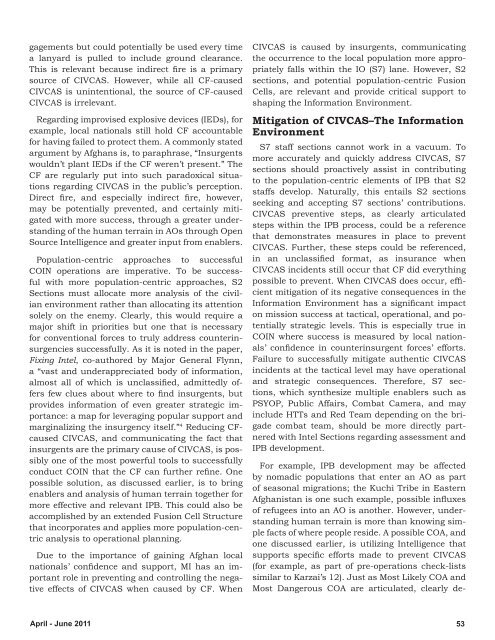George w. casey jr. - Federation of American Scientists
George w. casey jr. - Federation of American Scientists
George w. casey jr. - Federation of American Scientists
Create successful ePaper yourself
Turn your PDF publications into a flip-book with our unique Google optimized e-Paper software.
gagements but could potentially be used every time<br />
a lanyard is pulled to include ground clearance.<br />
This is relevant because indirect fire is a primary<br />
source <strong>of</strong> CIVCAS. However, while all CF-caused<br />
CIVCAS is unintentional, the source <strong>of</strong> CF-caused<br />
CIVCAS is irrelevant.<br />
Regarding improvised explosive devices (IEDs), for<br />
example, local nationals still hold CF accountable<br />
for having failed to protect them. A commonly stated<br />
argument by Afghans is, to paraphrase, “Insurgents<br />
wouldn’t plant IEDs if the CF weren’t present.” The<br />
CF are regularly put into such paradoxical situations<br />
regarding CIVCAS in the public’s perception.<br />
Direct fire, and especially indirect fire, however,<br />
may be potentially prevented, and certainly mitigated<br />
with more success, through a greater understanding<br />
<strong>of</strong> the human terrain in AOs through Open<br />
Source Intelligence and greater input from enablers.<br />
Population-centric approaches to successful<br />
COIN operations are imperative. To be successful<br />
with more population-centric approaches, S2<br />
Sections must allocate more analysis <strong>of</strong> the civilian<br />
environment rather than allocating its attention<br />
solely on the enemy. Clearly, this would require a<br />
major shift in priorities but one that is necessary<br />
for conventional forces to truly address counterinsurgencies<br />
successfully. As it is noted in the paper,<br />
Fixing Intel, co-authored by Major General Flynn,<br />
a “vast and underappreciated body <strong>of</strong> information,<br />
almost all <strong>of</strong> which is unclassified, admittedly <strong>of</strong>fers<br />
few clues about where to find insurgents, but<br />
provides information <strong>of</strong> even greater strategic importance:<br />
a map for leveraging popular support and<br />
marginalizing the insurgency itself.” 4 Reducing CFcaused<br />
CIVCAS, and communicating the fact that<br />
insurgents are the primary cause <strong>of</strong> CIVCAS, is possibly<br />
one <strong>of</strong> the most powerful tools to successfully<br />
conduct COIN that the CF can further refine. One<br />
possible solution, as discussed earlier, is to bring<br />
enablers and analysis <strong>of</strong> human terrain together for<br />
more effective and relevant IPB. This could also be<br />
accomplished by an extended Fusion Cell Structure<br />
that incorporates and applies more population-centric<br />
analysis to operational planning.<br />
Due to the importance <strong>of</strong> gaining Afghan local<br />
nationals’ confidence and support, MI has an important<br />
role in preventing and controlling the negative<br />
effects <strong>of</strong> CIVCAS when caused by CF. When<br />
CIVCAS is caused by insurgents, communicating<br />
the occurrence to the local population more appropriately<br />
falls within the IO (S7) lane. However, S2<br />
sections, and potential population-centric Fusion<br />
Cells, are relevant and provide critical support to<br />
shaping the Information Environment.<br />
Mitigation <strong>of</strong> CIVCAS–The Information<br />
Environment<br />
S7 staff sections cannot work in a vacuum. To<br />
more accurately and quickly address CIVCAS, S7<br />
sections should proactively assist in contributing<br />
to the population-centric elements <strong>of</strong> IPB that S2<br />
staffs develop. Naturally, this entails S2 sections<br />
seeking and accepting S7 sections’ contributions.<br />
CIVCAS preventive steps, as clearly articulated<br />
steps within the IPB process, could be a reference<br />
that demonstrates measures in place to prevent<br />
CIVCAS. Further, these steps could be referenced,<br />
in an unclassified format, as insurance when<br />
CIVCAS incidents still occur that CF did everything<br />
possible to prevent. When CIVCAS does occur, efficient<br />
mitigation <strong>of</strong> its negative consequences in the<br />
Information Environment has a significant impact<br />
on mission success at tactical, operational, and potentially<br />
strategic levels. This is especially true in<br />
COIN where success is measured by local nationals’<br />
confidence in counterinsurgent forces’ efforts.<br />
Failure to successfully mitigate authentic CIVCAS<br />
incidents at the tactical level may have operational<br />
and strategic consequences. Therefore, S7 sections,<br />
which synthesize multiple enablers such as<br />
PSYOP, Public Affairs, Combat Camera, and may<br />
include HTTs and Red Team depending on the brigade<br />
combat team, should be more directly partnered<br />
with Intel Sections regarding assessment and<br />
IPB development.<br />
For example, IPB development may be affected<br />
by nomadic populations that enter an AO as part<br />
<strong>of</strong> seasonal migrations; the Kuchi Tribe in Eastern<br />
Afghanistan is one such example, possible influxes<br />
<strong>of</strong> refugees into an AO is another. However, understanding<br />
human terrain is more than knowing simple<br />
facts <strong>of</strong> where people reside. A possible COA, and<br />
one discussed earlier, is utilizing Intelligence that<br />
supports specific efforts made to prevent CIVCAS<br />
(for example, as part <strong>of</strong> pre-operations check-lists<br />
similar to Karzai’s 12). Just as Most Likely COA and<br />
Most Dangerous COA are articulated, clearly de-<br />
April - June 2011 53















